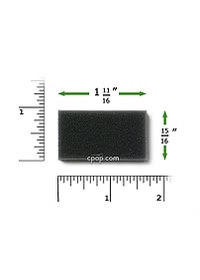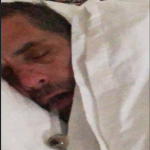Adding a Hypoallergenic filter
Adding a Hypoallergenic filter
Hi All,
I have a Remstar Plus M Series CPAP machine that I got in 2002. It came with the usual foam filter - about 1" x 1/2" x 3/4" or so - on the intake.
Wondering if it would help some allergy issues, I added a hypoallergenic filter to the intake.
In an unscientific test, I wanted to determine if the addition of the filter (using both foam and hypoallergenic) would restrict airflow. I tested this by blowing through each. The hypoallergenic filter passes air with MUCH greater effort than the foam - meaning it takes a lot more blowing to get air through it.
Since these are in the intake, and the hypoallergenic filter definitely reduces the airflow through there, does the machine automatically adjust to pull more air in and deliver the same pressure to my nasal pillow mask, or should I be adjusting the machine to know that the intake has been reduced.
I will say that I notice that the pressure to my nasal pillows is reduced somewhat. And when I take the mask off in the morning, I gulp fresh air down.
Seems obvious that it's cutting down on the pressure or airflow I need, but I'd love to hear what anyone else's experiences are.
Thanks,
Bob
I have a Remstar Plus M Series CPAP machine that I got in 2002. It came with the usual foam filter - about 1" x 1/2" x 3/4" or so - on the intake.
Wondering if it would help some allergy issues, I added a hypoallergenic filter to the intake.
In an unscientific test, I wanted to determine if the addition of the filter (using both foam and hypoallergenic) would restrict airflow. I tested this by blowing through each. The hypoallergenic filter passes air with MUCH greater effort than the foam - meaning it takes a lot more blowing to get air through it.
Since these are in the intake, and the hypoallergenic filter definitely reduces the airflow through there, does the machine automatically adjust to pull more air in and deliver the same pressure to my nasal pillow mask, or should I be adjusting the machine to know that the intake has been reduced.
I will say that I notice that the pressure to my nasal pillows is reduced somewhat. And when I take the mask off in the morning, I gulp fresh air down.
Seems obvious that it's cutting down on the pressure or airflow I need, but I'd love to hear what anyone else's experiences are.
Thanks,
Bob
- DreamStalker
- Posts: 7509
- Joined: Mon Aug 07, 2006 9:58 am
- Location: Nowhere & Everywhere At Once
Re: Adding a Hypoallergenic filter
M Series machines are supposed to already have 2 filters .... the outer most course grey foam filter and the inner white fine filter.
https://www.cpap.com/productpage-replac ... -CPAP.html


https://www.cpap.com/productpage-replac ... -CPAP.html


President-pretender, J. Biden, said "the DNC has built the largest voter fraud organization in US history". Too bad they didn’t build the smartest voter fraud organization and got caught.
Re: Adding a Hypoallergenic filter
Thanks. And maybe that's the problem. When I got the machine new in 2002, it was set up without the white filter - just had the foam. And I have used it like that for 14 years.
I've recently, when shopping for mask update parts, added the white filter. But am concerned it's messing with the air pressure to my mask because very little air goes through there when you blow through the white filter.
So, my question is, do I need to recalibrate my machine to accommodate the white filter and, if so, is there a stock offset number?
Thanks,
Bob
I've recently, when shopping for mask update parts, added the white filter. But am concerned it's messing with the air pressure to my mask because very little air goes through there when you blow through the white filter.
So, my question is, do I need to recalibrate my machine to accommodate the white filter and, if so, is there a stock offset number?
Thanks,
Bob
- chunkyfrog
- Posts: 34545
- Joined: Mon Jul 12, 2010 5:10 pm
- Location: Nowhere special--this year in particular.
Re: Adding a Hypoallergenic filter
You have been using the same machine for 14 Years?
Just curious--what are the run Hours?
More recent machines are commonly replaced much sooner.
Most insurance allows for 5 years, or machine malfunction, or both.
Just curious--what are the run Hours?
More recent machines are commonly replaced much sooner.
Most insurance allows for 5 years, or machine malfunction, or both.
_________________
| Mask: AirFit™ P10 For Her Nasal Pillow CPAP Mask with Headgear |
| Additional Comments: Airsense 10 Autoset for Her |
Re: Adding a Hypoallergenic filter
It's interesting that you feel that the air-volume/pressure is being reduced by the added filtration. Have you checked your data to see what's being reported?
If you proceed down this path, you might want to buy or build a manometer - needed to establish the pressure actually being delivered by the cpap.
I'd be worried that the added air-intake resistance could shorten the life-span of the cpap. Making it work harder likely will cause it to fail sooner.
If you proceed down this path, you might want to buy or build a manometer - needed to establish the pressure actually being delivered by the cpap.
I'd be worried that the added air-intake resistance could shorten the life-span of the cpap. Making it work harder likely will cause it to fail sooner.
I'm workin' on it.
Re: Adding a Hypoallergenic filter
No.uburoibob wrote:So, my question is, do I need to recalibrate my machine to accommodate the white filter and, if so, is there a stock offset number?
Actually the white filters were/are considered optional on all Respironics machines from the older models to the latest models. When the machines come from the factory they are all capable of either using both or just the gray foam filter without needing to do anything in terms of compensating for the addition of the white fine filters.
If you need to verify pressure output for your own peace of mind get a manometer and measure the air flow with and without the filter.
Probably would be a good idea anyway with a machine as old as yours.
You can buy one or make a simple one yourself. It's been discussed often on the forum and if you use the search function of the forum you can find those discussions.
_________________
| Machine: AirCurve™ 10 VAuto BiLevel Machine with HumidAir™ Heated Humidifier |
| Additional Comments: Mask Bleep Eclipse https://bleepsleep.com/the-eclipse/ |
I may have to RISE but I refuse to SHINE.
Re: Adding a Hypoallergenic filter
Thanks for all the posts. I will look into a manometer.
Total blower hours are 19,206. Average about 6.3 hours per night.
So, it's a probably good bet that restricting the airflow on the intake will not affect the air pressure on the output?
I am just wondering if I an sensing a problem
So, I reckon I should probably be looking into a new machine. As I recall, insurance didn't cover it.
Should I probably be thinking about a new study, or can those be done long distance these days via feedback from a machine, WiFi and the internet?
Thanks for all the answers!
Bob
Total blower hours are 19,206. Average about 6.3 hours per night.
So, it's a probably good bet that restricting the airflow on the intake will not affect the air pressure on the output?
I am just wondering if I an sensing a problem
So, I reckon I should probably be looking into a new machine. As I recall, insurance didn't cover it.
Should I probably be thinking about a new study, or can those be done long distance these days via feedback from a machine, WiFi and the internet?
Thanks for all the answers!
Bob
Re: Adding a Hypoallergenic filter
I just went back and, while I don't have a manometer, I judged the feel of the air coming through my mask with varying degrees of intake obstruction, and it does indeed affect outflow on this machine.
Probably best if I simply get a complete evaluation and a new machine that can tell me more info about my sleeping patterns (I've been reading through this forum). Seems things have come a long way since I bought my machine.
I love the compact size of it - any recommendations for something that has a small footrpint but is still full featured?
Thanks
Bob
Probably best if I simply get a complete evaluation and a new machine that can tell me more info about my sleeping patterns (I've been reading through this forum). Seems things have come a long way since I bought my machine.
I love the compact size of it - any recommendations for something that has a small footrpint but is still full featured?
Thanks
Bob
Re: Adding a Hypoallergenic filter
uburoibob, if you need additional filtration, you need to upgrade your machine. Unless you've had your machine tested with a manometer, chances are that the pressure you are getting now is not the pressure you have it set to. My brother's machine, after 8 years, failed the manometer test. It's off by 2 cm. We made a note on the machine to make that adjustment (he kept the machine as a backup).
_________________
| Mask: AirFit™ P10 Nasal Pillow CPAP Mask with Headgear |
| Additional Comments: Sleepyhead |
Diabetes 2, RLS & bradycardia
Airsense For Her; Settings: range 8-12, Airfit P10 (M)
Airsense For Her; Settings: range 8-12, Airfit P10 (M)
- DreamStalker
- Posts: 7509
- Joined: Mon Aug 07, 2006 9:58 am
- Location: Nowhere & Everywhere At Once
Re: Adding a Hypoallergenic filter
Do not confuse airflow with pressure ... they are not the same.
Your therapy is based on pressure NOT airflow. A manometer measures pressure.
It is fairly simple to make your own manometer but if you don't even know enough basic physics to know the difference between airflow (volume or velocity) and air pressure .... then you probably should just buy one instead.
Your therapy is based on pressure NOT airflow. A manometer measures pressure.
It is fairly simple to make your own manometer but if you don't even know enough basic physics to know the difference between airflow (volume or velocity) and air pressure .... then you probably should just buy one instead.
President-pretender, J. Biden, said "the DNC has built the largest voter fraud organization in US history". Too bad they didn’t build the smartest voter fraud organization and got caught.
Re: Adding a Hypoallergenic filter
You are correct, I don't know enough basic physics with respect to air volume, velocity and pressure. But can sorta see how pressure could theoretically be maintained with a variable flow of air velocity,DreamStalker wrote:Do not confuse airflow with pressure ... they are not the same.
Your therapy is based on pressure NOT airflow. A manometer measures pressure.
It is fairly simple to make your own manometer but if you don't even know enough basic physics to know the difference between airflow (volume or velocity) and air pressure .... then you probably should just buy one instead.
Well, let me ask this, then. If adequate 'pressure' is being maintained, then is it possible to have insufficient airflow to actually breathe properly? Could it be that my pressure is fine, but it's insufficient airflow that has me wanting to take big huge gulps of air when I take the mask off?
Just trying to understand a bit better.
Thanks,
Bob
- DreamStalker
- Posts: 7509
- Joined: Mon Aug 07, 2006 9:58 am
- Location: Nowhere & Everywhere At Once
Re: Adding a Hypoallergenic filter
If your machine is providing adequate pressure for your CPAP therapy, airflow is not relevant.uburoibob wrote:You are correct, I don't know enough basic physics with respect to air volume, velocity and pressure. But can sorta see how pressure could theoretically be maintained with a variable flow of air velocity,DreamStalker wrote:Do not confuse airflow with pressure ... they are not the same.
Your therapy is based on pressure NOT airflow. A manometer measures pressure.
It is fairly simple to make your own manometer but if you don't even know enough basic physics to know the difference between airflow (volume or velocity) and air pressure .... then you probably should just buy one instead.
Well, let me ask this, then. If adequate 'pressure' is being maintained, then is it possible to have insufficient airflow to actually breathe properly? Could it be that my pressure is fine, but it's insufficient airflow that has me wanting to take big huge gulps of air when I take the mask off?
Just trying to understand a bit better.
Thanks,
Bob
Generally, a volume of air is inversely proportional to pressure as stated by the "Ideal Gas Law". What that means is that when you exhale, your therapy pressure will increase very slightly relative to the other phase of your breath cycle when you inhale.
There are many factors that determine your CPAP pressure including the CPAP mask and any and all mask leaks, your tidal volume (amount of air exchanged between exhale and inhale), etc. However, the machine uses a pressure sensor to account for all the other variables in order to maintain the set pressure. It is possible that the pressure sensor may fail but you can only check for that with a manometer.
So to answer your last question, when you take your mask off, there will be a sudden negative change in therapy pressure to your circuit (ie. lungs, throat, mouth, mask, hose) relative to your atmospheric environment because it was under increased pressure (your CPAP therapy pressure). If you are at the exhale portion of your breathing cycle when you take your mask off, you will have a feeling of wanting to gulp for air due to added negative change in pressure .... however, if you are at the inhale cycle of your breath when you take your mask off, it will still be a negative change in pressure but you will not feel the need to gulp for air as much. That is why I always take my mask off right at completion of of my inhale and not my exhale. It won't kill you if you do it at exhale but it is just more comfortable taking the mask off at the inhale part of breath.
The CPAP therapy on the other hand should be the pressure required to keep your airway open ... especially as your breath goes from complete inhale to beginning of exhale, when your airway is most likely to collapse and cause obstruction to airflow. The CPAP machine will automatically add sufficient air to your circuit to maintain that pressure. If your machine cannot add enough air to maintain that pressure then you may need a new machine. But you cannot determine that just by estimating airflow with your hand. Hence, you need to buy or make a manometer to see if your machine can maintain your therapy pressure ... not your machine airflow.
President-pretender, J. Biden, said "the DNC has built the largest voter fraud organization in US history". Too bad they didn’t build the smartest voter fraud organization and got caught.
Re: Adding a Hypoallergenic filter
the machine adjusts automatically to pull in the same amount of air to generate the same pressure.uburoibob wrote:\Since these are in the intake, and the hypoallergenic filter definitely reduces the airflow through there, does the machine automatically adjust to pull more air in and deliver the same pressure to my nasal pillow mask,
if it pulled in MORE air, then that would cause your pressure to be higher.
any differences are either a result of a faulty machine, or your preconceptions affecting your subjective measurement of pressure delivered. (the only way to objectively know what pressure you're getting, and whether the filter is affecting it, is with a manometer.)
Get OSCAR
Accounts to put on the foe list: dataq1, clownbell, gearchange, lynninnj, mper!?, DreamDiver, Geer1, almostadoctor, sleepgeek, ajack, stom, mogy, D.H., They often post misleading, timewasting stuff.
Accounts to put on the foe list: dataq1, clownbell, gearchange, lynninnj, mper!?, DreamDiver, Geer1, almostadoctor, sleepgeek, ajack, stom, mogy, D.H., They often post misleading, timewasting stuff.
Re: Adding a Hypoallergenic filter
maybe. the flow generator can only create so much flow, if the amount of flow required to maintain your adequate pressure is near the upper limit of the maximum possible flow, then when you inhale, it won't be able to increase flow enough, and pressure will fall.uburoibob wrote:Well, let me ask this, then. If adequate 'pressure' is being maintained, then is it possible to have insufficient airflow to actually breathe properly? Could it be that my pressure is fine, but it's insufficient airflow that has me wanting to take big huge gulps of air when I take the mask off?
of course, this would result in higher apnea events, which you would know if you monitored your performance data, a thing that is more difficult with the machine you have than with modern machines.
building a simple water manometer with some tubing and hooking it up to the end of your hose before your mask would answer the question easily. search the forum for instructions how.
Get OSCAR
Accounts to put on the foe list: dataq1, clownbell, gearchange, lynninnj, mper!?, DreamDiver, Geer1, almostadoctor, sleepgeek, ajack, stom, mogy, D.H., They often post misleading, timewasting stuff.
Accounts to put on the foe list: dataq1, clownbell, gearchange, lynninnj, mper!?, DreamDiver, Geer1, almostadoctor, sleepgeek, ajack, stom, mogy, D.H., They often post misleading, timewasting stuff.
Re: Adding a Hypoallergenic filter
So, looking at new machines, I am thinking an S9. Looks like the evolution of what I have. And I can get AHI reporting with that? What other cool stuff will I be getting with a new machine? What should I be thinking about?
Thanks,
Bob
Thanks,
Bob










